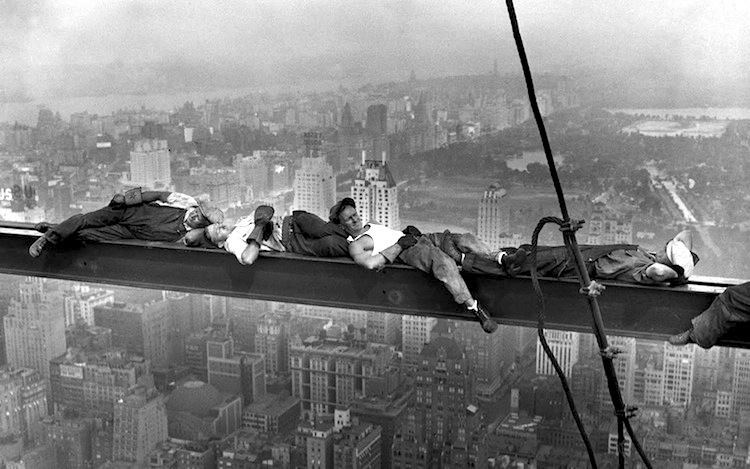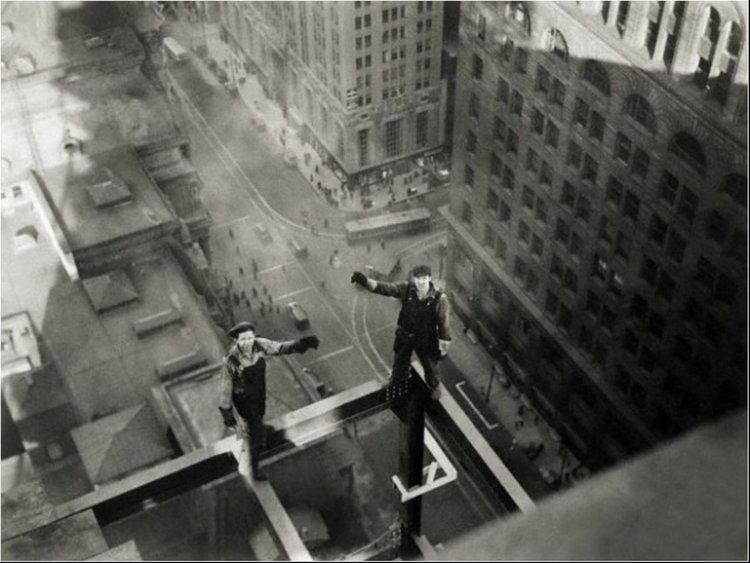Name Charles Ebbets Role Photographer | Died July 14, 1978 | |
 | ||
Great names charles clyde ebbets
Charles Clyde Ebbets (August 18, 1905 – July 14, 1978) was an American photographer who is credited with having taken the iconic photograph Lunch atop a Skyscraper (1932).
Contents
- Great names charles clyde ebbets
- Ravensburger Puzzle Lunch Atop A Skyscraper 1000 Pcs
- Biography
- Early career
- Lunch atop a Skyscraper
- Later career
- References

Ravensburger Puzzle - Lunch Atop A Skyscraper - 1000 Pcs
Biography
Ebbets was born in August 18, 1905 in Gadsden, Alabama to Samuel, a drum manufacturer, and Minnie Ebbets. He bought his first camera at age eight by charging it to his mother's account at a local drugstore. He married Josephine Ward on September 1, 1928 in Broward, Florida. His second wife was Mary Green, with whom he had a son, Charles. His third wife was Laurie Chase, who he married in 1938.
Early career

Ebbets started his career during the 1920s in St. Petersburg, Florida, as a still photographer. He eventually became involved in early motion picture work, both in front of and behind the camera. In 1924, he had a brief stint as an actor, playing the role of an African hunter known as "Wally Renny" in several motion pictures. Throughout the 1920s, Ebbets had many other jobs including pilot, wing-walker, auto racer, wrestler, and hunter. He was also prizefighter Jack Dempsey's official staff photographer, a staff photographer for the Miami Daily News, and a freelance photographer.

In 1927, the first attempt was made to traverse the entirety of the dirt road from Miami to Tampa, called the "Tamiami Trail". Ebbets was chosen to be one of the three men making the trip by virtue of his extensive knowledge of the region and wildlife and his ability with a camera to document the adventure for newspapers and the Essex Motor Company who sponsored the trip and car. The photos of their success were carried in newspapers across the country.
Lunch atop a Skyscraper
By the 1930s Ebbets was a well-known photographer and had work published in major newspapers across the nation, including the New York Times. In 1932, Ebbets was appointed the Photographic Director for the Rockefeller Center's development. On September 29, 1932, he took the photo Lunch atop a Skyscraper, which depicts eleven men sitting on a girder eating lunch, their feet dangling from the beams hundreds of feet above the New York streets. The photo was taken on the 69th floor of the RCA Building in the last several months of construction. It has been postulated that multiple photographers collaborated on the shoot, however, the Ebbets family has produced verified written records of Ebbets' authorship including original receipts on Ebbets' professional letterhead showing his billing for the work done on the shoot, an original glass negative of Ebbets at work that day on the beam adjacent to the workmen, other original images taken by Ebbets during his work at Rockefeller Center, photos of the image displayed in Ebbets' office at Rockefeller Center, as well as copies of the original article from 1932 showing the famous photo which were found in his personal scrapbook. All of these documents supporting Ebbets' authorship have been independently verified by professional researchers, intellectual property attorneys and private investigators. During the photo's worldwide circulation over the past 20 years, no other photographer nor any photographer's estate has ever claimed authorship of the famous image.
Later career
In 1933 Ebbets moved back to Florida where he was to live and work for the rest of his life. His interests were now focused on the exciting growth of tourism in the state, the unique Seminole Indians and the vast expanse of untouched nature in the Everglades. In 1935, Ebbets became the first official Associated Press photographer in the state. That same year, his photos of the infamous 1935 Labor Day hurricane that devastated the Florida Keys were circulated worldwide. During this era, he also founded the Miami Press Photographers Association and was its first President.
His extensive knowledge of the Everglades and closeness to the people of the region led to a unique friendship with many of the members of the Seminole Indian tribe. Over time, he counted many of the tribal leaders among his personal friends and was allowed unprecedented access to the villages and camps to document their lives in pictures. In 1938, he was the first white man ever allowed to witness their sacred Green Corn Dance and was permitted to photograph the entire week-long event. Many of these images were seen in the pages of newspapers throughout the country, and this extensive collection remains one of the finest of its kind in the world.
For the next decade, Ebbets continued his travel and adventures both on and off assignment, and broke his back while shooting photos in the Everglades, an injury which kept him out of the military during World War II. However, because he was a licensed pilot and a photographer, he served as an attaché to the Army Air Corps Special Services and would later be assigned to Embry-Riddle Aeronautical Institute, which was training the American and British Royal Air Forces. During the war, he documented all phases of base development and personnel training in Florida and spent time in South America working under General "Hap" Arnold, who oversaw the training of American and British pilots at bases in Brazil.
Ebbets returned to his Miami home at the end of World War II and would be one of the three founders of the City of Miami Publicity Bureau. For the next 17 years he was the Chief Photographer of the City of Miami. During this period Ebbets would expand his collection of Everglades birds and wildlife images and would document the growth of Miami as a mecca of the tourist industry. He was a pioneer in creating some of the first cheesecake photographs that touted Miami as a winter respite for adventure and warm weather among beautiful scenery and people. His photographs were featured in the Miami Daily News, The New York Times, National Geographic, Outdoors Unlimited, Field & Stream, Popular Boating, U.S. Camera, Outdoor Life, Look Magazine, Popular Photography (the June 1938 issue featured a full spread about Ebbets and his work), and others.
Throughout the 1970s Ebbets continued to photograph life in the South Florida region. On July 14, 1978, at the age of 72, Ebbets died of cancer. At the time of his death he had more than 300 nationally published images.
In 2003, he was honored at the Photo East Expo held at the Javits Center in New York by Corbis, which has at least 21 of Ebbets' pictures in its collection. Currently, his daughter has established a website of some of his images which can be seen at EbbetsPhoto-Graphics.com and is archiving and restoring his vast collection of pictures to be included in a book about his life and work.
